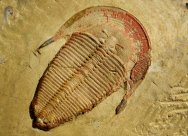Trilobite Order Harpetida
Harpetid Trilobites |
Page within: Class Trilobita - Trilobite Classification |
|
Harpetida became a distinct trilobite order only recently in 2002, after being split from Order Ptychopariida in which they were suborder Harpina. The Harpetids are most often considered to be descended from the Ptychopariids. Moreover, the Harpetida are now often considered to be a member of the Librostoma, a suborder erected by Fortey in 1990 to encompass Ptychopariida, Harpetida, Asaphida, and Proetida based in part on the shared trait of a natant hypostomal attachment (i.e., a hypostome mouthpart not anchored to the anterior doublure).
Ebach, M.C. & K.J. McNamara.
2002. A systematic revision of the family Harpetidae (Trilobita).
Records of the Western Australian Museum 21:135-67. | |||||||||||||||||||||||||||
Fossil
Museum Navigation:
Home Geological Time Paleobiology Geological History Tree of Life Fossil Sites Fossils Evolution Fossil Record Museum Fossils |





